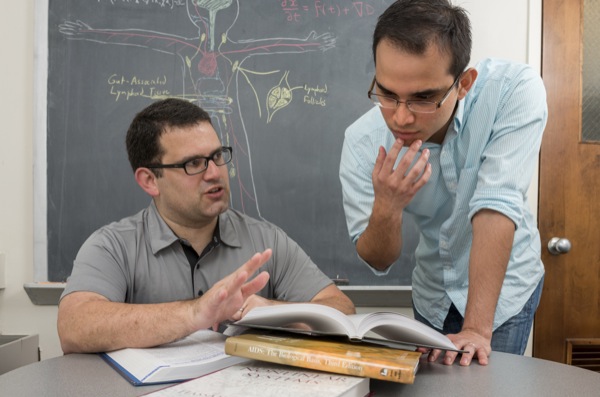
HIV advance
UD-led team develops mathematical model to measure hidden HIV
7:02 p.m., May 7, 2013--Scientists have long believed that measuring the amount of HIV in a person’s blood is an indicator of whether the virus is actively reproducing.
A University of Delaware-led research team reports new evidence that hidden virus replication may be occurring within the body’s tissue, despite undetectable virus levels in the blood.
Research Stories
Chronic wounds
Prof. Heck's legacy
The findings were reported in the Journal of the Royal Society Interface on May 8 in a paper titled “Modelling HIV-1 2-LTR dynamics following raltegravir intensification.”
The discovery came after the paper’s lead author, Ryan Zurakowski, assistant professor of electrical and computer engineering, and his research team created a mathematical model to represent how HIV infected cells reproduce.
Antiviral therapy, Zurakowski explained, suppresses HIV replication in most patients until the concentration of virus in a blood sample is undetectable. It is unclear whether similar suppression occurs in other tissues, known as sanctuary sites, including lymph nodes where most HIV is found.
“The majority in the HIV community have always believed that the drugs are penetrating sanctuary sites perfectly well and that the blood is a good surrogate measurement of these sites,” he said. “Our model gives us a way to measure this hidden virus replication, which has not been done before.”
The research team used the model to analyze data from a clinical study in which researchers added a new drug, an integrase (enzyme) inhibitor, to the cocktail HIV patients were already taking. Patients tested were on a steady three-drug protocol for at least two years before adding the fourth drug, and never exhibited any measurable virus in their bloodstream.
According to Zurakowski, the inhibitor prevented the HIV DNA from integrating into a cell's chromosomes and caused the HIV DNA to bind its two ends together making a small DNA circle called a 2-LTR. The team’s mathematical model revealed that 2-LTR circles can be measured in the blood and demonstrate virus replication in other tissues. It also showed that several patients with undetectable virus levels in their blood nevertheless had significant uncontrolled HIV replication in other tissues
“The genius of looking for 2-LTR circles is that infected cells can’t survive the trip from the sanctuary site to the blood, and neither can the HIV, but the 2-LTR circles live as long as the cells that they are resident in, which is about 10-20 days,” he said.
He continued on to say that the only thing stopping the virus from infecting more cells was that it was running out of healthy cells to attack. The team calculated that the virus infected and killed between 1 million and 100 million cells daily, numbers Zurakowski said are high enough that eventually it would lead the patient to develop a drug resistant HIV virus and to experience treatment failure.
Zurakowski said that for 30 percent of the patients in the study, adding integrase inhibitor caused 2-LTR measurements only explainable if the patient had uncontrolled virus replication in sanctuary sites in the body.
For HIV patients and the scientific community, the discovery implies that current antiretroviral therapies may not be as complete in suppressing HIV as previously hoped. Because the fourth drug causes additional 2-LTR’s to be created, the model may also offer a new way to measure, through a blood test, whether HIV is reproducing in sanctuary sites in the body.
Zurakowski’s team is collaborating with researchers at the IrsiCaixa Institute in Barcelona, Spain, and at the University of California, San Francisco, to design a new study to confirm these findings, and to quantify the HIV turnover rates in the sanctuary sites. The team will also look at whether the model can suggest new treatment approaches that could be more effective.
About the research team
Ryan Zurakowski joined UD in 2006. In addition to his faculty role in electrical and computer engineering, he is also affiliated with the Delaware Biotechnology Institute and holds appointments within the Department of Mathematical Sciences and the biomedical engineering program. His research centers on nonlinear control theory and applications, specifically in mathematical biology and medicine.
Zurakowski’s previous work includes developing a treatment method to reduce the risk of future failures in patients who have already experienced failure with their HIV treatment protocol. The research involved developing model-based approaches that minimize the risk of treatment failures for HIV patients who are switching therapies by considering both the contributions of viral load to the probability of failure.
Co-authors on the paper include Rutao Luo and Fabian Cardozo (University of Delaware); Michael Piovoso (Pennsylvania State University); Hulin Wu (University of Rochester); Maria Buzon (IrsiCaixa Foundation, Barcelona, Spain) and Javier Martinez-Picado (IrsiCaixa Foundation and ICREA, Barcelona, Spain).
About the grant
Research reported in this article was supported by the National Institute of Allergy and Infectious Diseases of the National Institutes of Health under award numbers R21AI078842 (for Zurakowski at UD) and RO1 AI087135 and P30 AI078498 (for Hulin at University of Rochester).
Article by Karen B. Roberts
Photo by Kathy F. Atkinson








